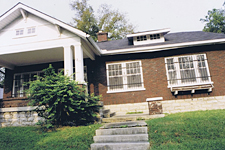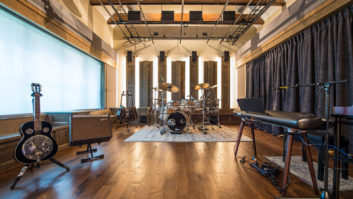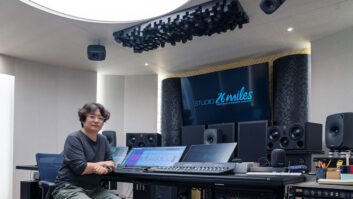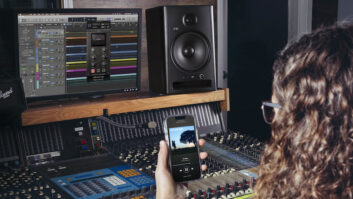
It’s one thing to run a recording studio. It’s a whole different ball of wax to build a space from the ground up. But that’s exactly what the husband and wife team of Larry Sheridan and Robin Ruddy, founders of Nashville’s Parlor Productions, did. From purchase to total transformation, the duo created a character-filled recording studio on Music Row 10 years ago, and they’ve been making it work ever since. It was far from an easy—or short—process. Here’s the story on how they managed to survive.
The Big Decision
In the mid-1990s Sheridan and Ruddy, who had been a songwriting/production/musician team for a long time, realized that they were ready for a new challenge and wanted to build a serious recording studio. Their decision to begin what Sheridan refers to as “the insanity” was simple: They had been recording songs for nearly 30 years in various types of recording scenarios, and by the time they started their publishing company, Best Built Songs, in 1994, the two were working in an 11×11-foot room. But as their skills and gear grew, the room shrunk. That’s when the “brand new studio” bug bit them. “We wanted to do a lot more with recording, songwriting and artist development, so we started looking for a property that would accommodate all of our goals,” says Sheridan.
In 1998, Larry Sheridan and Robin Ruddy discovered this single-story brick house on Nashville’s Music Row.
That same year, the two set out to find a space that would not only meet their physical space requirements, but also serve as a solid real estate investment. Because they already owned a property in Nashville’s Music Row, they knew that if they chose wisely, their property value would increase, so a space in a prime location became a very important factor in their decision-making. Four years after their search had begun, they found what they had been looking for: a single-story, outdated brick house situated right in the heart of Music Row.
“We knew that we would have to do major renovations to the space, and we didn’t want to jump into such a huge project without really considering the different factors,” says Ruddy. “After looking at everything very thoroughly, we came to the conclusion that this was the property that would be best in terms of location, value, and real estate investment.” Though the property, which had been used by country music star Randy Travis as a storage shed for concert paraphernalia, was “junky and filled with rotten wood,” the 1928 home also had a special charm that attracted the two immediately. Plus, while the property was originally a residence, it enjoyed special zoning privileges that allowed owners to use it for commercial purposes.
Several months after their big find, on Halloween in 1998, Sheridan and Ruddy settled on the property and began the major renovations that would ultimately transform the one-story, 1,600-square-foot house into a two-story, 4,200-square-foot recording studio facility and office space.
The Planning
Before shovel met dirt, however, Sheridan and Ruddy had to make an enormous amount of preparations. The first two months were spent heavily entrenched in design and finance challenges. Sheridan, who had extensive experience building studios for clients, served as the general contractor; he was responsible for designing both the interior and exterior of the space, and immediately began putting together drawings and, in December, obtaining permits.
“The pressure was really on us because building codes were scheduled to change in January, so we were trying to push it through before then,” remembers Sheridan. Needless to say, they didn’t make it in time. However, remarkably, the code changes wound up benefiting the project and changed the plans for the building. “There were some critical changes with boundary allotments that let us expand the layout a little differently when it came to entering the building,” says Sheridan, who threw out his original, hand-drawn drawings and started the time-intensive process all over again. However, given Sheridan’s experience with studio construction, the changes and challenges didn’t come as a big surprise.
Sheridan’s ability to visualize the potential of a space also proved extremely useful in the project, as the property they selected would undergo a complete makeover from the inside out. “Larry is really good at looking at a space, envisioning what it can be and then creating a picture of what it will turn out to be in the end,” says Ruddy.
Sheridan and Ruddy gutted most of the house’s interior.
“The only thing on the outside that we kept was the brick façade and the front porch,” explains Sheridan. Much of the interior was gutted, except for key pieces like a stone fireplace in the “parlor” area and some original flooring. In addition, Sheridan and Ruddy decided to add a second story to the property because they believed it would provide them with space that could be used for commercial office purposes, which would, in turn, generate some extra revenue.
Sheridan and Ruddy decided to add a second story to the property because they believed it would provide them with space that could be used for commercial office purposes.
The Transformation
Once the ground behind the space was stripped away, Sheridan called upon acclaimed studio designer Michael Cronin, who happened to be a friend of a friend. “He came over one morning, surveyed the property, and began describing to us how the space should flow,” recalls Sheridan. Then, after the project was still in sticks, he came over again and reviewed the layout, wall by wall. “There were a few weeks we sat around and had coffee and talked about what we wanted to do with the space from an architectural standpoint,” says Sheridan. It was then that they made the decision that would give Parlor Productions its famous look—and name.
While most studio owners were opting for the high-tech look and feel, incorporating the “latest and greatest,” Sheridan and Ruddy decided they wanted to keep the integrity of the 1920s style of the house. A trip to Sheridan’s grandmother’s home in New York provided further inspiration. “Her house had an old-fashioned parlor in it,” recalls Sheridan. “Once I saw that, I got the idea to create that type of look and feel for the studio, and when we got back to Nashville, we had a good idea of what we wanted to do architecturally and design-wise.”
Parlor Productions’ design aesthetic includes brass chandeliers that hang in the tracking room.
With design elements including antique fabrics for the walls, rich
hardwood floors, brass chandeliers that hang in the tracking room, and
other architectural nuances, the owners emphasized the building’s 1920s
authenticity. “The décor is a reflection of the way we wanted the
studio to feel: homey and not outwardly high-tech, even though it is
very high-tech beneath the surface,” explains Ruddy. “We wanted people
to feel comfortable here.” Apparently, that goal was met; one of the
most common remarks Ruddy and Sheridan hear now is how at home clients
feel while recording in the space.
The Guts
Behind the homey architectural design, however, lies
a sophisticated technical network. This aspect of the project proved
the most challenging. “Wiring was a tremendous undertaking,” says
Sheridan. “We had three guys who, for 30 days straight, worked on the
wiring—soldering, crimping, and building the patchbay.” Sheridan adds
that he built electrical conduits into the slab because he knew where
all of the walls would be added. He also carefully considered the
physics of the space. To deal with unbalanced walls, unbalanced glass,
and the decoupling of walls, the decision was made to create isolated
slabs. This required an enormous supply of materials. “The whole studio
is not a huge place, but when all was said and done, you could have
built two to three homes with the amount of materials we had to
purchase,” says Sheridan. “We had 320 12-foot sheets of sheetrock,
thousands of feet of insulation, numerous double walls and double
doors, and countless treatments.”
Parlor Productions’ live room includes a Yamaha grand piano
And of course, Sheridan and Ruddy wouldn’t be able to call their new
space a recording studio without the proper gear. Parlor Productions
features a vast assortment of equipment, including a
Digidesign/Focusrite Control 24 console; Pro Tools HD3 with 32 inputs;
Alesis MasterLink; Vintech X73s; UA 1176s; Hafler, Mackie and Yamaha
amplifiers and monitors; API 3124 mic pre’s; multiple plug-ins; and a
smattering of other equipment.
The Dollars
Not surprisingly, the one-and-a-half-year
project was massive, both in terms of its scope as well as the
financial resources required. According to Ruddy, however, every bit of
it has been worthwhile. “The cost we incurred was astronomical. The
renovation alone cost more than the property itself, and that was with
Larry working hands-on full time at it, and me pitching in part-time,”
admits Ruddy. “But once it was all said and done and we more than
doubled the size of the property, brought it up to code and created a
viable business here. The property value more than doubled, so the cost
was relative to the equity in the real estate.”
The renovated building retained the original brick façade and front porch.
Ruddy and Sheridan have also benefited financially from their decision
to add a second story and lease the space to tenants. In fact, they
were fortunate enough to enjoy a major tenant right from the beginning.
“Back in 2000, when we first opened our doors, Emerald Studios, which
had eight different spaces and was very big in Nashville at the time,
approached us to be tenants because they had heard that Michael Cronin
had been involved in our project,” explains Sheridan. “They used the
second floor space for their administrative offices, so all of a
sudden, we had someone helping to pay the notes on the property, which
was a tremendous help.
Not only did this help generate leasing revenue, but it also drew
major-label work for Sheridan and Ruddy. “Having Emerald occupying our
second floor space definitely gave us a leg up on the competition at
the time,” says Sheridan, who is also a producer. In fact, Parlor has
hosted such country stars as John Michael Montgomery and Kenny Chesney,
along with major artists in contemporary Christian music like Amy
Grant, Vince Gill, Point of Grace, and Stephen Curtis Chapman, as a
result of their affiliation with Emerald.
While the music industry and the Nashville music scene have changed
dramatically over the past several years, and many studios have closed
their doors and record labels have folded, Parlor is still going
strong. In addition to developing several young up-and-coming artists,
the studio recently recorded album projects for music legends Charlie
Pride and the Jordanaires. They’ve also begun to add several new
services to their repertoire, including artist and songwriter
development.
Musicians prepare for a session in Parlor Productions’ live room.
“It’s really rewarding to be able to look back all those years ago at
our goal of producing demos and developing songwriters and artists, and
know that we were able to accomplish it,” says Sheridan. “I love the
fact that I am able to sit in the producer’s chair of the space that we
created and work with a band of hot-shot session players in the studio,
and build what I record into something that sounds like a record. It is
truly an emotional high.”
Ruddy offers this advice: “If you really want to open and create a
studio, you’ve got to be willing to dive right in. There are challenges
that you’ll face, but there are challenges in every aspect of life. If
you want it, you’ve got to go after it. I wouldn’t have it any other
way; what I get to do every day as a result of what we’ve built is
better than anything I could have imagined.”
Studio Unknown is full-service audio post-production facility and
recording studio that specializes in helping clients discover creative
sound for film, video, Web, gaming, and artist projects. For more
information, visit www.studiounknown.com.







